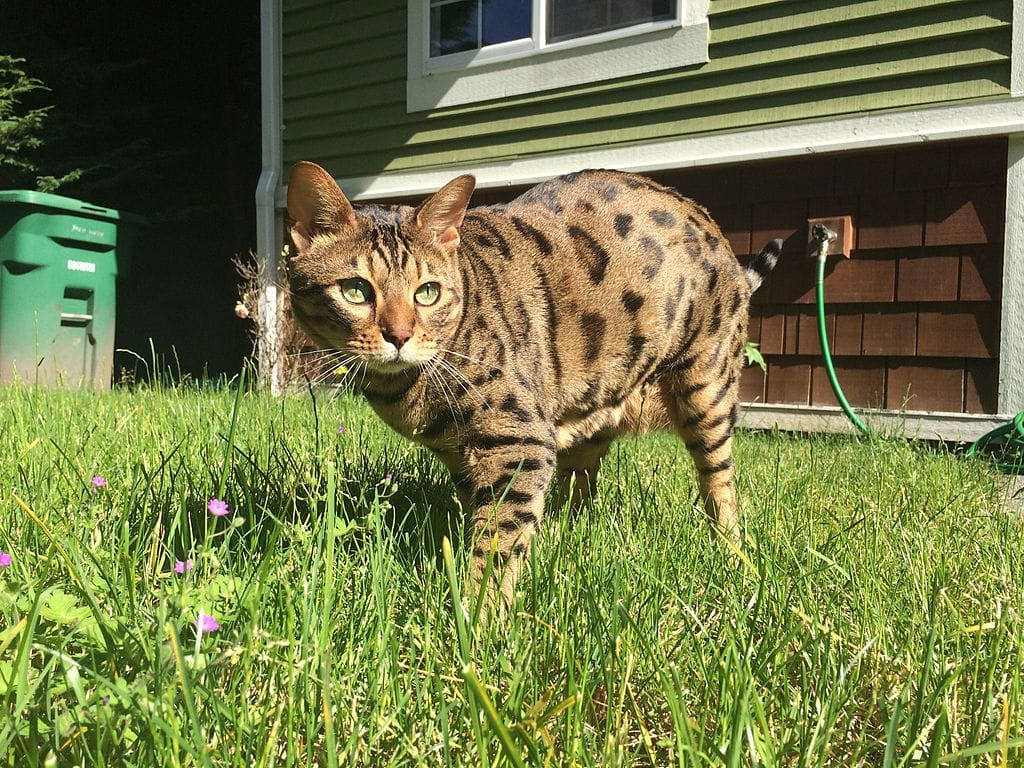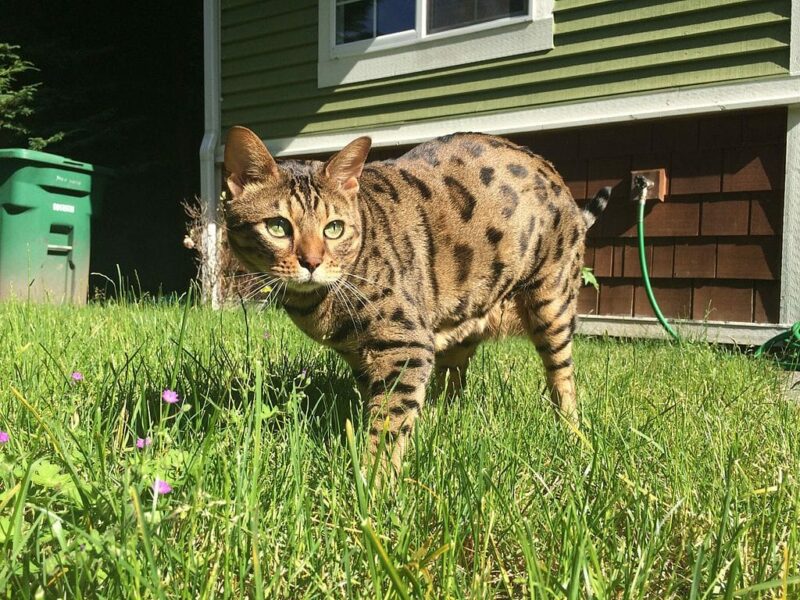Are you looking for a cat to adopt but want one that lets you take a walk on the wild side? Look no further than the Cheetoh cat! You may not be able to adopt an actual wild cat (and for good reason), but you can get the look of one with this adorable cat breed. This hybrid kitty has a fabulous coat that looks just like a wild cat’s, but they have the temperament of a house cat.
If you want to learn more about this gorgeous feline, here’s a closer look at everything you need to know before adopting a Cheetoh cat, such as how long they live, how big they get, and what their needs are. Keep reading!
Breed Overview
Height:
8–15 inches
Weight:
12–25 pounds
Lifespan:
12–14 years
Colors:
Brown spotted, snow spotted, silver spotted, cinnamon spotted, blue marbled, snow marbled, brown marbled
Suitable for:
Large and active families
Temperament:
Talkative, energetic, curious, sociable, affectionate
The Cheetoh cat is a newer hybrid breed created in the United States in 2003. Born from the Bengal and the Ocicat, this sweet feline is known for having an energetic, playful nature and being one of the most affectionate kitties around. This is one cat with whom you’ll never be bored!
Cheetoh Cat Characteristics
Cheetoh Kittens
Cheetoh cats are still rare, so you may have trouble locating a kitten. You’ll definitely need to go through a breeder for one of these felines (unless you are lucky enough to stumble across one in your local shelter, but chances of that happening are low). Ensure you’re adopting from a reputable breeder, though, and be aware that you’ll be paying more for a Cheetoh cat than you would for many other breeds.
If you don’t mind an older cat, you may be able to locate a Cheetoh through a Bengal or Ocicat rescue group (though there aren’t many of those out there). However, Ocicats and Bengals are growing in popularity, so hopefully, it won’t be long before there’s more desire for Cheetoh cats too!
Temperament & Intelligence of the Cheetoh Cat
Cheetoh cats might look wild, but they are among the sweetest, most affectionate cat breeds! These beautiful felines are incredibly gentle and extremely social, so they love to hang out with their families. They’re also quite active; don’t be surprised if this kitty wakes you at the crack of dawn to play or if you find them causing mischief like turning on faucets or opening cabinets.
Cheetoh cats are highly intelligent. They quickly pick up on things and adapt easily to new situations. These cats also love attention! Your Cheetoh cat will come to you for attention all day long, so be prepared to spend tons of quality time with them.
Are These Cats Good for Families? 👪
Absolutely! In fact, Cheetoh cats are better suited to families than singles, and the larger the family, the happier they’ll be. These kitties love nothing more than being around people and dislike being on their own, so having someone always there for them will make them incredibly happy.
since these felines get along with practically everyone, they do well with kids. Just be sure that small children know how to play within the kitty’s boundaries so no one gets injured!
Also, keep in mind that Cheetohs are highly energetic, so they won’t be thrilled with those who are quieter and less inclined to activity. These kitties need lots of attention and plenty of time to play.
Does This Breed Get Along With Other Pets?
The Cheetoh’s friendliness doesn’t only extend to humans; these felines get along well with other pets too. They will make quick friends with other cat breeds, though you may want to stick with more energetic breeds for playmates; otherwise, the second cat could easily get fed up with the Cheetoh for being too playful!
Cheetohs can make friends with dogs too, provided that the pups aren’t overly aggressive. Cheetohs aren’t particularly territorial and love being around others, so they’re generally fine with sharing space with other animals (at least, as long as they still get a fair amount of attention!).
These are still felines, though, so they may see smaller animals, such as gerbils, as prey, not friends.
Things to Know When Owning a Cheetoh Cat
What else does one need to know before adopting a Cheetoh cat? Here’s a look at how much exercise these kitties need, their dietary requirements, grooming needs, and more!
Food & Diet Requirements 🐡
Cheetoh cats don’t require any kind of particular diet other than that of the average feline. As an obligate carnivore, your cat should be getting a diet that’s high in protein that comes from quality meat. Cheetohs might need a bit more protein than other cat breeds to keep up with all that boundless energy, but beyond that, just be sure you’re feeding your pet high-quality food. Be careful not to overfeed your kitty! Too much food can cause weight gain, resulting in health problems.
Remember to keep plenty of fresh water out for your Cheetoh!
Exercise 🐈
Since they’re a highly energetic breed, the Cheetoh cat will require plenty of exercise. They love to play and can quickly grow bored if they have nothing to do. While these cats can entertain themselves (they love to climb, so invest in plenty of cat towers!), they’ll want to play with their families all the time too. Engage with them with a quick game of fetch, a wand, or the fan-favorite cat laser!
Besides cat towers, you’ll want plenty of scratching posts in your home. Also, ensure that your kitty has more than one window they can sit at to view the outside world, as this will help keep them entertained.
Training 🧶
Many people believe that only dogs can be trained, but cats can be too! The Cheetoh cat is one of the more easily trainable breeds. Due to their high intelligence, these felines are quick to pick up on things, so you shouldn’t have a lot of trouble teaching them tricks, how to walk on a leash, or games like fetch.
When training a Cheetoh cat, you’ll want to use positive reinforcement. Use treats and praise when they figure out how to do what you’re teaching them, and remember never to yell at your cat.
Grooming ✂️
The Cheetoh has a short, sleek coat that doesn’t require a lot of grooming. They also are a minimal shedder. You should still brush your cat at least once a week, though, to keep their beautiful coat looking fabulous. Weekly brushing also has the benefit of letting you bond with your cat!
Besides a weekly brushing, you should keep your Cheetoh’s nails trimmed. These felines love to climb things, so if they have longer nails, furniture in your home could get scratched up when they do so (and longer nails are more uncomfortable for your cat). You should also brush your Cheetoh’s teeth regularly to prevent dental disease.
Health and Conditions 🏥
The good news is that Cheetoh cats tend to be very healthy, and as of now, there are few known diseases to which they are prone. They are a newer breed, though, so that could change.
- Sensitivity to anesthetics
- Luxating patella
- Heart disease
- Cataracts
Male vs. Female
Female and male Cheetohs don’t have many differences. Males of this breed will be slightly larger than the females, but all Cheetohs will be playful, friendly, and affectionate. One unique thing about male Cheetohs, though, is that they will take care of their young, which isn’t the norm for most cat breeds.
No matter which sex you choose to go with, consider getting your Cheetoh neutered or spayed. Doing so will not only prevent pregnancy, but it also has several health benefits for your cat.
3 Little-Known Facts About the Cheetoh Cat
Want to know even more about these adorable felines? Here are a few facts about Cheetohs you may not have known!
1. Cheetoh Cats Are Considered Hypoallergenic
Although no felines are truly hypoallergenic, those that don’t shed a lot or produce much dander are often considered hypoallergenic (though it’s the proteins in a cat’s saliva that people are mostly allergic to). Due to the minimal shedding of these felines, they fall into that category.
2. Cheetohs Are Chatterboxes
These kitties love to talk, so be prepared to have yours chattering at you at all hours. First-time owners might be concerned if they hear lots of meowing at night, but this is normal, talkative behavior for this breed.
3. The Cheetoh Isn’t Recognized by Most Associations and Organizations
The Cheetoh breed is new enough that they aren’t recognized by most associations and organizations, such as the Cat Fanciers’ Association. However, the breed has been recognized by The International Cat Association.
 Final Thoughts
Final Thoughts
The Cheetoh cat is a fun and adorable feline that makes a fantastic pet for large, active families. This kitty adores hanging out with their people and playing; they’ll even enjoy being friends with other pets in the home. You will need a lot of energy to keep up with this cat, though, as they are constantly on the move and ready to play!
See also:
- 8 Games to Play With Your Indoor Cat: Vet-Reviewed Options
- How Many Teeth Does a Cat Have? Vet-Approved Facts & Infographic
Featured Image Credit: Cheetoh Cat In Grass (Image Credit: Chris Rue, Wikimedia Commons CC0 4.0 International)
Contents
- Cheetoh Cat Characteristics
- Cheetoh Kittens
- Temperament & Intelligence of the Cheetoh Cat
- Things to Know When Owning a Cheetoh Cat
- 3 Little-Known Facts About the Cheetoh Cat
- 1. Cheetoh Cats Are Considered Hypoallergenic
- 2. Cheetohs Are Chatterboxes
- 3. The Cheetoh Isn’t Recognized by Most Associations and Organizations
- Final Thoughts












